当前位置:
X-MOL 学术
›
Clin. Genet.
›
论文详情
Our official English website, www.x-mol.net, welcomes your
feedback! (Note: you will need to create a separate account there.)
Phenotypic bases of NOTCH2NLC GGC expansion positive neuronal intranuclear inclusion disease in a Southeast Asian cohort.
Clinical Genetics ( IF 2.9 ) Pub Date : 2020-06-30 , DOI: 10.1111/cge.13802 Zhiyong Chen 1 , Zheyu Xu 1 , Qianhui Cheng 2 , Yi Jayne Tan 1 , Helen L Ong 3 , Yi Zhao 3 , Weng Khong Lim 4, 5 , Jing Xian Teo 4 , Jia Nee Foo 6, 7 , Hwei Yee Lee 8 , Jeanne M M Tan 1 , Liting Hang 7 , Wai-Yung Yu 2 , Simon K S Ting 9 , Eng-King Tan 9, 10 , Tchoyoson C C Lim 2 , Adeline S L Ng 1, 10
Clinical Genetics ( IF 2.9 ) Pub Date : 2020-06-30 , DOI: 10.1111/cge.13802 Zhiyong Chen 1 , Zheyu Xu 1 , Qianhui Cheng 2 , Yi Jayne Tan 1 , Helen L Ong 3 , Yi Zhao 3 , Weng Khong Lim 4, 5 , Jing Xian Teo 4 , Jia Nee Foo 6, 7 , Hwei Yee Lee 8 , Jeanne M M Tan 1 , Liting Hang 7 , Wai-Yung Yu 2 , Simon K S Ting 9 , Eng-King Tan 9, 10 , Tchoyoson C C Lim 2 , Adeline S L Ng 1, 10
Affiliation

|
Neuronal intranuclear inclusion disease (NIID) is a neurodegenerative disorder associated with GGC repeats of >60 to 500 copies in the 5′‐untranslated region of NOTCH2NLC. The clinical and genetic characterization of NIID outside of East Asia remains unknown. We identified twelve patients who underwent genetic testing using long‐read sequencing or repeat primed polymerase chain reaction. All were positive for a GGC repeat expansion; the median repeat length was 107 (range 92‐138). Ten were Chinese and two of Malay ethnicity. Age at onset ranged from 50 to 69 years. Eight (66.7%) patients had dementia, while four (33.3%) patients were oligosymptomatic, without typical NIID symptoms of dementia, Parkinsonism, or muscle weakness. GGA interruptions within the GGC expansion were present in four patients; the number of GGA interruptions was highest (6.71%) in the patient with the earliest age at onset (50 years). Median plasma neurofilament light level was 47.3 pg/mL in seven patients (range 26‐380 pg/mL). The highest level (380 pg/mL) was found in one patient who experienced an encephalitic episode. Overall, we describe a cohort of genetically confirmed NIID patients from Southeast Asia and provide further information that the presence of GGA interruptions within GGC repeat expansions may serve as a potential genetic modifier in NIID.
中文翻译:

在东南亚队列中,NOTCH2NLC GGC扩展阳性神经元核内包涵体疾病的表型基础。
神经元核内包涵体病(NIID)是一种神经退行性疾病,与NOTCH2NLC的5'-非翻译区中GGC重复> 60至500拷贝有关。在东亚以外的国家,NIID的临床和遗传特征仍然未知。我们确定了十二名接受长期测序或重复引发聚合酶链反应的基因测试的患者。所有人都对GGC重复扩展表示乐观;中位重复长度为107(范围为92-138)。十个是华人,两个是马来人。发病年龄为50至69岁。8例(66.7%)的患者患有痴呆症,而4例(33.3%)的患者是无症状的,没有典型的NIID痴呆症,帕金森病或肌肉无力症状。GGC扩张内的GGA中断出现在4例患者中。在发病年龄最早(50岁)的患者中,GGA中断次数最高(6.71%)。7名患者的血浆神经丝中线水平为47.3 pg / mL(范围26-380 pg / mL)。在一名脑病发作患者中发现最高水平(380 pg / mL)。总的来说,我们描述了一组来自东南亚的经过基因确认的NIID患者,并提供了进一步的信息,即GGC重复扩增内GGA中断的存在可能是NIID中潜在的遗传修饰因子。
更新日期:2020-08-27
中文翻译:

在东南亚队列中,NOTCH2NLC GGC扩展阳性神经元核内包涵体疾病的表型基础。
神经元核内包涵体病(NIID)是一种神经退行性疾病,与NOTCH2NLC的5'-非翻译区中GGC重复> 60至500拷贝有关。在东亚以外的国家,NIID的临床和遗传特征仍然未知。我们确定了十二名接受长期测序或重复引发聚合酶链反应的基因测试的患者。所有人都对GGC重复扩展表示乐观;中位重复长度为107(范围为92-138)。十个是华人,两个是马来人。发病年龄为50至69岁。8例(66.7%)的患者患有痴呆症,而4例(33.3%)的患者是无症状的,没有典型的NIID痴呆症,帕金森病或肌肉无力症状。GGC扩张内的GGA中断出现在4例患者中。在发病年龄最早(50岁)的患者中,GGA中断次数最高(6.71%)。7名患者的血浆神经丝中线水平为47.3 pg / mL(范围26-380 pg / mL)。在一名脑病发作患者中发现最高水平(380 pg / mL)。总的来说,我们描述了一组来自东南亚的经过基因确认的NIID患者,并提供了进一步的信息,即GGC重复扩增内GGA中断的存在可能是NIID中潜在的遗传修饰因子。











































 京公网安备 11010802027423号
京公网安备 11010802027423号